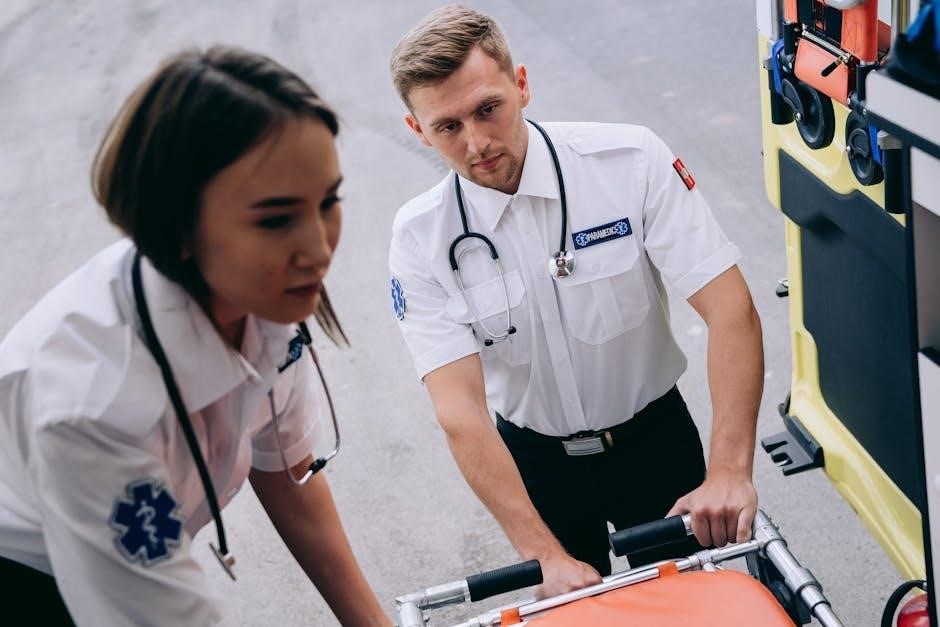Non-Emergency Medical Transportation (NEMT) provides safe, efficient, and compliant transportation for patients requiring medical services. This manual outlines essential policies, procedures, and regulations to ensure patient safety, operational efficiency, and compliance with federal and state laws governing NEMT services.
1.1. Definition and Scope of NEMT Services
Non-Emergency Medical Transportation (NEMT) refers to the transportation of patients who require medical care but do not need urgent or emergency services. It includes scheduled appointments, routine medical visits, and pre-planned procedures. NEMT services are designed to ensure safe, comfortable, and timely transportation for individuals with medical needs, bridging gaps in healthcare access while adhering to regulatory standards.
1.2. Importance of NEMT Policies and Procedures
NEMT policies and procedures are essential for ensuring compliance with federal and state laws, maintaining patient safety, and optimizing operational efficiency. They provide clear guidelines for drivers, providers, and administrators, minimizing risks and ensuring consistent service delivery. Adherence to these standards enhances trust, accountability, and overall quality of care in non-emergency medical transportation services.

Eligibility Criteria for NEMT Services
Eligibility for NEMT services is determined by medical necessity, enrollment in Medicaid or Dr. Dynasaur programs, and specific transportation needs. Criteria ensure access to essential care;
2.1. Patient Eligibility Requirements
Eligibility for NEMT services requires patients to have a verified medical need for transportation, enrollment in Medicaid or qualifying programs, and inability to use public transport. Specific conditions, such as disabilities or chronic illnesses, may qualify patients for these services, ensuring access to necessary medical care while adhering to program guidelines and requirements.
2.2. Provider Qualifications and Certification
Providers must meet specific qualifications, including vehicle safety standards, proper licensing, and insurance. Drivers must complete mandatory training programs, pass background checks, and obtain necessary certifications. Vehicles must undergo regular inspections to ensure compliance with regulations. Certification requirements vary by state but typically involve adherence to federal and state laws governing NEMT services.
Covered Services and Exclusions
Covered services include non-emergency transportation to medical appointments, dialysis, and rehab. Exclusions may apply for non-medical trips, luxury services, or unauthorized providers.
3.1. Types of Covered Transportation Services
Covered transportation services include trips to medical appointments, dialysis, rehabilitation, and therapy sessions. Wheelchair-accessible vehicles are provided for patients with mobility challenges. Ground transportation, such as ambulettes or buses, is also covered when medically necessary. Services must be pre-approved and documented as part of the patient’s treatment plan to ensure eligibility and compliance with NEMT policies.
3.2. Services Not Covered Under NEMT
Services not covered under NEMT include non-medical trips, luxury vehicle requests, and transportation for non-healthcare purposes. Services requiring emergency response or advanced life support are excluded, as are trips without prior authorization. Additionally, transportation for recreational or social activities is not covered, ensuring NEMT resources are reserved for essential medical needs only.
Scheduling and Dispatching Procedures
NEMT scheduling involves arranging transportation through approved platforms or call systems. Dispatching prioritizes trips based on urgency, ensuring timely pickups and efficient routing for all patients.
4.1. How to Arrange NEMT Services
Arranging NEMT services involves coordination between healthcare providers, patients, and transportation vendors. Eligible patients or their representatives can request services through approved platforms or call systems. Documentation, such as medical necessity forms, must be submitted. Providers verify eligibility and schedule trips, ensuring compliance with policies and procedures to guarantee timely and efficient transportation.
4.2. Dispatching Protocols and Prioritization
Dispatching protocols ensure efficient management of NEMT trips, prioritizing based on medical urgency and resource availability. Real-time systems track vehicle locations and availability, optimizing trip assignments. Dispatchers follow established procedures to handle special requests, ensuring compliance with policies and timely service delivery. Prioritization is guided by patient needs, service level agreements, and operational efficiency to maintain high-quality transportation services.

Vehicle and Equipment Requirements
Vehicles must meet strict safety standards and undergo regular inspections to ensure compliance. Essential medical equipment and supplies must be maintained to provide safe and reliable transportation services.
5.1. Vehicle Safety Standards and Inspections
Vehicles used for NEMT must meet rigorous safety standards, including regular inspections to ensure roadworthiness. All vehicles must be equipped with essential safety features, such as first aid kits, fire extinguishers, and proper seating. Compliance with state and federal regulations is mandatory to guarantee patient and driver safety during transportation.
5.2. Medical Equipment and Supplies
NEMT vehicles must carry essential medical equipment and supplies to address patient needs during transport. This includes first aid kits, stretchers, oxygen tanks, and blood glucose monitors. All equipment must be regularly inspected, maintained, and updated to ensure functionality and compliance with safety standards, guaranteeing optimal patient care and safety during transportation.
Driver Training and Certification
NEMT drivers must complete mandatory training programs, including first aid, emergency procedures, and patient handling. Certification ensures drivers meet regulatory standards, promoting safe and reliable patient transport.
6.1. Mandatory Training Programs for Drivers
NEMT drivers must undergo comprehensive training, including first aid, emergency procedures, and patient handling. Programs cover safety protocols, vehicle operations, and compliance with federal and state regulations; Training ensures drivers are equipped to handle diverse patient needs, promoting safe and efficient transportation. Regular updates and recertification are required to maintain high standards of care and operational excellence.
6.2. Certification Requirements for NEMT Drivers
NEMT drivers must obtain certifications in first aid, CPR, and patient handling. State-specific licensing and background checks are mandatory. Drivers must also complete NEMT-specific training and maintain valid certifications. Regular recertification ensures adherence to updated standards and regulations, guaranteeing safe and compliant patient transportation services.

Compliance with Regulations
Compliance with federal and state laws, HIPAA, and privacy protections is essential for NEMT operations. Adherence ensures legal, efficient, and patient-trustworthy services.
7.1. Federal and State Laws Governing NEMT
Federal and state laws, including HIPAA, ADA, and Medicaid regulations, govern NEMT operations. Compliance with these laws ensures patient rights, privacy, and accessibility. State-specific licensing and certification requirements further regulate NEMT services, ensuring adherence to safety and operational standards. Understanding these legal frameworks is critical for providers to maintain compliance and avoid penalties.
7.2. HIPAA and Privacy Protections
NEMT providers must comply with HIPAA regulations to protect patient health information (PHI). This includes secure handling, storage, and transmission of PHI. Drivers and staff must undergo privacy training to ensure confidentiality. Breaches of HIPAA can result in penalties, emphasizing the importance of strict adherence to privacy protocols in all NEMT operations.

Incident Management and Reporting
Incident management ensures timely responses to accidents or complaints, with clear procedures for documentation, investigation, and resolution. This process enhances safety, accountability, and compliance in NEMT operations.
8.1. Procedures for Handling Complaints
The NEMT Complaints Management Policy outlines structured steps for addressing grievances. Upon receipt, complaints are documented, assessed, and investigated promptly. A resolution plan is developed, with findings communicated to the complainant. This process ensures transparency, accountability, and continuous improvement in service delivery, aligning with regulatory standards and patient expectations.
8.2. Incident Reporting and Documentation
Incident reporting involves documenting all adverse events during transportation. Detailed records must include incident type, date, location, and parties involved. Timely submission to supervisors ensures compliance with safety protocols. Proper documentation helps in investigations, improving future operations and maintaining regulatory standards to prevent recurrence.
Continuous Quality Improvement
Continuous Quality Improvement ensures ongoing enhancement of NEMT services through regular audits, feedback implementation, and service monitoring to maintain high standards and compliance.
9.1. Auditing and Monitoring NEMT Services
Regular audits and monitoring of NEMT services ensure compliance with policies, identify gaps, and improve service quality. This process involves reviewing vehicle inspections, driver certifications, and documentation. Data collection and analysis help track performance metrics, ensuring patient safety and operational efficiency. Continuous oversight guarantees adherence to federal and state regulations, maintaining high standards for healthcare transportation.
9.2. Implementing Feedback for Service Enhancement
Feedback from patients, drivers, and staff is crucial for enhancing NEMT services. A structured process ensures feedback is reviewed, analyzed, and acted upon to address concerns and improve quality. This may include updating training programs, refining policies, or adopting new technologies to better meet patient needs and ensure compliance with regulatory standards.
Non-Emergency Medical Transportation is essential for ensuring access to healthcare while prioritizing patient safety and efficiency. Adhering to policies and procedures guarantees high-quality service delivery and compliance with regulations, fostering trust and reliability in the NEMT system.
10.1. The Role of NEMT in Healthcare Delivery
Non-Emergency Medical Transportation (NEMT) plays a critical role in healthcare delivery by ensuring patients access necessary medical services safely and efficiently. It bridges gaps in transportation, reduces missed appointments, and supports vulnerable populations, making healthcare more accessible and equitable for all individuals in need of non-urgent medical care.
10.2. Future Directions for NEMT Services
The future of NEMT services lies in innovation, integration, and expansion. Advancements in technology, such as AI-driven dispatch systems and real-time tracking, will enhance efficiency. Expanding service offerings to include specialized medical transportation and integrating with broader healthcare systems will improve accessibility. These developments aim to address growing demand and ensure high-quality, equitable care for all patients.
